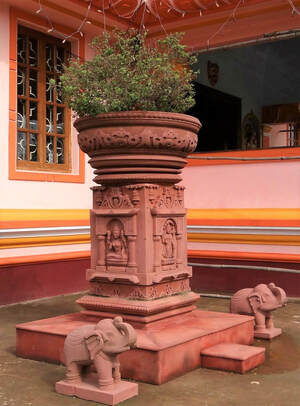 I love walking barefooted, feeling the grass, earth and tiny pebbles brush my feet. A simple yet joyful connection to earth. Earth day falls on April 22nd this year, highlighting more than ever, the need to heal our planet. COVID-19 pandemic has mercilessly halted normal lives but as we learn to accept these uncertain times, we are compelled to slow-down and enjoy this pause. Pictures of people admiring blue skies as pollution levels plummet in cities and stories of families enjoying home cooked meals together, is comforting. In our moment of collective reflection, we can acknowledge human misuse/abuse of nature and understand the necessity to restore ecological balance. Ancient wisdom and age-old customs reveal the harmonious relationship that humans shared with their environment. Yoga is an ancient system of well-being, deeply rooted in honoring the Laws of Nature. Yogic systems along with Ayurveda (knowledge of life and longevity), talk extensively about cosmology and the five elements, Pancha Mahabhutas (Pancha-five, Maha-great, bhuta-element) which are earth, water, fire, air and space (David Frawley). These systems of holistic wellness indicate that all the elements that exist around us in nature, manifest within us as well. Ancient rituals performed by our ancestors honored the elements of earth, water, fire, air and space. 5000-8000 year old Hindu texts of Vedas (1) and Puranas have enshrined the five elements as "Divine" and "life-giving" forces. Ancient Greeks, Egyptians, Native Americans and other old civilizations also showed great reverence to the Gods of nature. Various rituals were performed to ascertain that all five elements were in balance with each other and us! Earth (Bhumi) In India, Mother Earth is represented by the Goddess Bhudevi or Bhumidevi similar to the Greek mythological Goddess of Earth, Gaia. Bhu or Bhumi (Earth) Devi (Goddess) is portrayed as a loving mother, who nourishes and feeds her children. Practices of composting, crop rotation and caring for earth have existed since early times. Even today many families continue to practice traditions that honor the Earth Goddess by performing a ritual called Bhumi Puja, before using any piece of land either for tilling or construction. Another beautiful tradition prevalent since early ages in Indian households is planting Holy Basil (Tulsi) within home grounds (as seen in the picture). It is believed that worshiping a Tulsi plant (considered the abode of Gods), will lead you to Moksha or liberation. Scientifically, Holy Basil acts as an air purifier, helps reduce stress and has anti-bacterial properties (2). Unsurprisingly, our ancestors were aware of it's benefits, both spiritually and environmentally! Customs which extol the sacredness of plants and trees, remind us to pause and re-assess the environmental harm we may be causing. By afforestation methods, decreasing our carbon footprint and living in accordance with nature, we can restore our planet. Yoga practices help us appreciate and become aware of the elements of nature. Postures like tree pose (Vrikshasana) or cobra (Bhujangasana) have several health benefits and were adopted by yogis after carefully observations of wildlife and nature. Another aspect to remember is that we practice yoga postures barefooted, aware of the ground that supports us and earth that helps us find balance! Water (Jala) Much like oceans, rivers, lakes and streams occupy about 70% of our planet, human bodies are made up of about 70% water! Dry spells and droughts have caused major famines and wiped out villages. Most ancient cultures worshiped the Water Gods to bless them with ample rainfall for the crops to grow. Rivers and streams have been vital for civilizations to flourish. River Ganges (Ganga) is considered the holiest of all rivers in India. It originates from the Himalayas and flows down into the plains, nourishing everything in its path (3). Prayers and rituals are performed on the banks of river Ganges to honor this Goddess for her compassion, nourishment, the power to cure diseases and help attain Moksha. When we develop deep gratitude and respect for resources that sustain us, we learn to take care of them. In yoga, we transition between postures with fluidity, aware of our thoughts, movements and flow of breath! Fire (Agni) Earth is powered by Sun’s energy. Fire rituals or yagnas/hawan in India have been in practice since early times and are performed to invoke blessings of the Fire God or Agni. Several aromatic/medicinal plants, herbs, essential oils etc. are offered in a fire-pit (hawan-kund) during the ceremony. Vapors that emanate are supposed to have therapeutic, mental and physiological health benefits along with cleansing/air purifying properties (4). Fire rituals also symbolize the destruction of negative tendencies/fears/vices that we may harbor. Like the heat from Sun helps living beings grow and stay warm, in Yoga and Ayurveda, the concept of heat extrapolates to fire inside our bodies, also called Agni. Symptoms of improper digestion, dullness/lethargy or slow metabolism among others, are attributed to the imbalance in agni or digestive fire inside our bodies. Yoga uses the power of breath and movement to balance agni in our bodies. An energizing practice will increase digestive fire and help regain strength. Tapas/mental discipline/motivation also comes from keeping the fire element in our bodies balanced. Air (Vayu) All ancient cultures feared the Wind God, for he was powerful and could cause tornadoes and fierce storms. Ancient scriptures point to destruction caused by the heavy winds when the Gods were upset. In India, Wind God or Vayu, is known to be powerful, heroic and swift. Yoga identifies this energy or life force in our body as Prana Shakti (Divine energy). Pranayama methods are yogic breathing practices that oxygenate our bodies, leading to physical, mental health as well as emotional well-being. Learning pranayama with an experienced teacher will get you started on your own journey towards better health and wellness. Please follow my video below for an introduction to pranayama! Space (Akasha) The concept of space(ananta-infinite space) in yoga and spirituality is complex. Space provides the substratum for all other elements to manifest. According to Ayurveda, humans share the same five elements (Pancha Mahabhutas) that exist in nature. We realize that we are one with everything that surrounds us and must live in harmony with nature. Isn’t this the perfect way to balance our ecosystem? To understand the notion of space, a peek into our regular lives is needed. Are we leading lives ridden with stress and anxiety? Is there too much to do and little time to accomplish tasks? Mindful life -by slowing down and decluttering an overfull schedule, we can create space in our life. Mindful body -with the practice of yoga postures and breathing, our bodies become flexible. Prana moves effortlessly. Openness/space in mind -we learn to let go of old painful memories and future worries and instead live in the present moment. We manage stress by not reacting to situations. The practice of meditation can elevate us to an open mental field. I truly hope that our lives will return to normal in the next few weeks/months. In the meanwhile, let's pause, reflect and maybe change some of our habits that are in opposition to our health, as well as our ecosystem. I would like to end with folded hands, bowing down to each one of you, saying "Namaste", which means that I am bowing down to the Divine that exists in you. Yoga believes that each one of us is Divine in nature and we are all One. If we learn to see the best in each one of us, our world will be a happier and more compassionate place to live in. Stay well and healthy.
6 Comments
Anjum Kaushik
4/10/2020 02:20:46 pm
Great article!! I am always learning something new from your articles , you are doing a great job . Keep it up
Reply
4/10/2020 04:19:15 pm
Thanks so much Anjum! I really enjoyed writing this blog. It seemed relevant to address the fragility of our relationship with nature!
Reply
Sangeeta Singh
4/10/2020 08:52:07 pm
You are an ocean of knowledge bhabhi! Such a deep article, written with much fluidity. You always have my attention.
Reply
4/11/2020 03:33:45 pm
Thanks Sangeeta. It's always a joy to write for a wonderful audience:)
Reply
Arlene Cohen
4/11/2020 04:41:59 pm
Thank You. With our mental and physical health being so fragile during this difficult time, I welcome your wonderful words.
Reply
4/14/2020 11:37:50 am
So happy to hear from you Arlene! I hope we can resume our regular chair yoga sessions soon. Take acre and stay well.
Reply
Leave a Reply. |
Author : Deepti GuptaAll of us have a story to tell. Turning life's experiences into stories is empowering and fulfilling. I feel fortunate to have a platform where meaningful discussions can materialize. Thanks for joining me! Here we wander not to get lost but to self-explore! Archives
December 2022
Categories |
Search by typing & pressing enter

 RSS Feed
RSS Feed